


 |
Pape's 1902 story in #5 |
Every once in a while I'll start to work on one of these biographies and learn something that sends a shiver down my spine. This is one, as you will see...
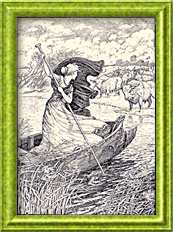
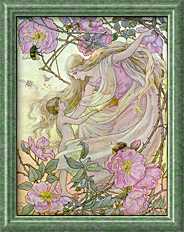 Frank
Cheyne Papé (pronounced "paw PAY") was born in
1878. That's around the time of Mabel Lucie Attwell, Cyrus Cuneo,
Norman Lindsay,
Harry Rountree, Frank Schoonover,
J. Allen St.
John, and Ernest H. Shepard. While I can't find any specific
statement of the fact, it appears that he was born in England.
His earliest recorded work is circa 1908, which seems to eliminate
him from the "child prodigy" contingent or else he spent
his early career in a commercial venue where credits were not
given. (see update below)
Frank
Cheyne Papé (pronounced "paw PAY") was born in
1878. That's around the time of Mabel Lucie Attwell, Cyrus Cuneo,
Norman Lindsay,
Harry Rountree, Frank Schoonover,
J. Allen St.
John, and Ernest H. Shepard. While I can't find any specific
statement of the fact, it appears that he was born in England.
His earliest recorded work is circa 1908, which seems to eliminate
him from the "child prodigy" contingent or else he spent
his early career in a commercial venue where credits were not
given. (see update below)
That early work, like Children of the Dawn (left) was somewhat anachronistic with elements of Walter Crane and other artists of the Nineties. Even his color work, like the image from The Story Without End (right) had an old-fashioned feel to them. Think of what Rackham and Dulac were doing about the same time (c1912).
It's very difficult for me to pin down with exactitude the dates of much of his early work. Blame it on the British and their inexplicable annophobia (fear of dates - I just made that up). For reasons which have never been made clear to me, books published in England seldom declared their year of publication. They were very big on telling you who printed each and every tome, but the 'when' was almost always kept secret.
 Sometime
early in his career, while he was still working in color, Papé
did illustrations for a series of fairy tale books. At left is
an example from The Ruby Fairy Book and he also did plates
for The Diamond Fairy Book and The Golden Fairy Book.
These were probably done prior to WW1, because soon after the
war, he would settle into the black & white style with which
we're most familiar.
Sometime
early in his career, while he was still working in color, Papé
did illustrations for a series of fairy tale books. At left is
an example from The Ruby Fairy Book and he also did plates
for The Diamond Fairy Book and The Golden Fairy Book.
These were probably done prior to WW1, because soon after the
war, he would settle into the black & white style with which
we're most familiar.
Pure speculation time: Every reference that I have found on Papé begins with some version of "Little information is available..." on him. In the preparation of this essay, I was struck by two things. The first was that his first work doesn't appear until he's 30 and the second was that he only produced one book during WWI.
If he was actually born in 1878, he would have been 36 years old when WWI began and probably a bit old for conscription. Of course, he could easily have enlisted. But, what if he had been born in 1888? His first work would have been done at age 20 (a much more likely starting age based on the vast majority of the artists I've profiled) and he would have been a prime candidate at 26 for the war effort. Since "little information is available" we can't discount the possibility of the accepted birth date being wrong. Again, this is simply speculation on my part. Back to the regularly scheduled biography...
update January 2010: I was recently apprised by John G.F. Clement that Frank Papé illustrated a book written by Mr. Clement's great grandfather in 1902! This book was Naughty Eric and other stories from Giant, Witch, and Fairyland and was published by Syd H.E. Foxwell of The Globe Press. So we can officially move his earliest work back to when he was 24 - a much more reasonable age to begin a career. Thanks, John! Reproductions from the book are available in B&W ImageS #5.
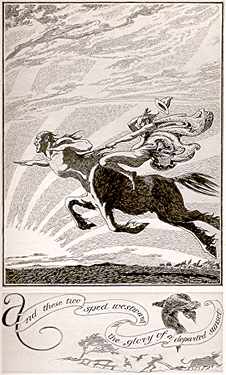 With
the publication of the limited illustrated edition of Jurgen
in 1921, Frank C. Papé became an "overnight"
success. James Branch Cabell's 1919 novel had been the beneficiary
of a suppression in New York on moral grounds and, of course,
became his most famous work to date. (The book was cleared in
1922 when it was found that the erotic symbolism could only be
detected by the sophisticated reader...)
Papé's illustrations were reproduced in photogravure for
the plates and b&w for the images within the text. The plates
debuted a new style and a device he was to use to great effect
for years: an illustrated border below the main image. The frontispiece
was to be one of his last published color paintings.
With
the publication of the limited illustrated edition of Jurgen
in 1921, Frank C. Papé became an "overnight"
success. James Branch Cabell's 1919 novel had been the beneficiary
of a suppression in New York on moral grounds and, of course,
became his most famous work to date. (The book was cleared in
1922 when it was found that the erotic symbolism could only be
detected by the sophisticated reader...)
Papé's illustrations were reproduced in photogravure for
the plates and b&w for the images within the text. The plates
debuted a new style and a device he was to use to great effect
for years: an illustrated border below the main image. The frontispiece
was to be one of his last published color paintings.
It's incorrect to consider the style to be old-fashioned, but it wasn't au courant, either. Combining the fine line of an etching with a mixture of superb draftsmanship and tongue-in-cheek satire, it was something entirely new. Click on the Jurgen image at right for another, larger and more detailed image from the book.
Other Cabell books followed. A year or so after a new novel appeared, the Papé-illustrated version was released. The sexual satire increased to the point where in Something About Eve, the woman shown is serving her husband his testicles and more for dinner. The style evolved, too, to the point where it seems almost certain that Theodore Geisel incorporated aspects of it into Dr. Seuss.
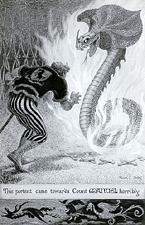
|
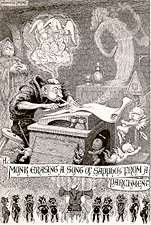
|
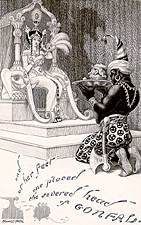
|

|
| Figures of Earth (1925) | The Cream of the Jest (1927) | The Silver Stallion (1928) | Something About Eve (1929) |
In addition, he illustrated two other Cabell books, The Way of Ecben (1929) and Domnei (1930).
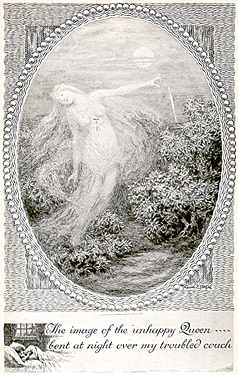 With
the success of Jurgen, Papé was in demand to illustrate
similar satire. Anatole France won the Nobel Prize for Literature
in 1921 and his social satire was a perfect vehicle. Papé
was commissioned to illustrate a uniform set of his most famous
books. At the Sign of the Reine Pédauque (1922), The
Revolt of the Angels (1924), Penguin Island (1925),
Thais (1926), The Well of St. Clare (1928), and
Mother of Pearl (1929) were issued in the same black and
gilt format as the Cabell books and are often mistaken for a matched
set.
With
the success of Jurgen, Papé was in demand to illustrate
similar satire. Anatole France won the Nobel Prize for Literature
in 1921 and his social satire was a perfect vehicle. Papé
was commissioned to illustrate a uniform set of his most famous
books. At the Sign of the Reine Pédauque (1922), The
Revolt of the Angels (1924), Penguin Island (1925),
Thais (1926), The Well of St. Clare (1928), and
Mother of Pearl (1929) were issued in the same black and
gilt format as the Cabell books and are often mistaken for a matched
set.
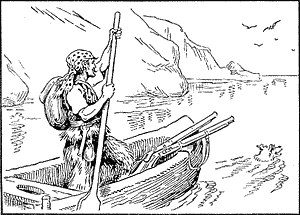 As you can see from the plate from Mother of Pearl at
left, he was just as capable of drama and serious illustration
as he was at home with the satirical. It was this direction that
would guide most of the rest of his career.
As you can see from the plate from Mother of Pearl at
left, he was just as capable of drama and serious illustration
as he was at home with the satirical. It was this direction that
would guide most of the rest of his career.
Suetonius' Lives of the Twelve Caesars (1930) was a major new translation with a strong suite of 16 plates in photogravure with only hints of humor. As was his 1927 Complete Works of Doctor François Rabelais. But after a few titles in the early thirties: like The Picture Story of Robinson Crusoe (1933), Tales From the Arabian Nights (1934) and Rachel the Immortal (1935), his career came to a very abrupt stop.

Or did it? In November 1943, an obscure new magazine for children was published in Chicago. The editor, Ramon Peyton Coffman tells in the first issue editorial how he has been writing a newspaper column for children called Uncle Ray's Corner. In response to requests for a collection of the columns, Uncle Ray's Magazine was created. Well, if this is a collection of some of those newspaper columns, then we know where Frank Papé disappeared to after 1935 because every illustration in the 32 page magazine is by him. And he continues to do most of the art for the next ten years! He's listed as "Art Director" in the November 1947 issue (the next one I have after #1, above) and for most issues afterwards. The latest issue I have is from June of 1952.
Well, as I mentioned earlier, there's not a lot about Papé in the reference material I have, so I went out on the net to see what else I could find. Imagine my surprise when I discovered the Guide to the Frank Cheyne Papé Letters and drawings, ca. 1921-1931. It's a library collection of his letters and contracts regarding the illustration of and containing the drawings for seven of his most famous books:
Figures of Earth - 25 original drawings
Jurgen - 35 original drawings
Penguin Island - 1 original drawings
Rabelais - 55 original drawings
La Reine Pédauque - 33 original drawings
Revolt of the Angels - 22 original drawings
Thais - 23 original drawings
Now imagine the chill that ran up my spine when I realized that these illustrations are at Stanford University, not five miles from where I'm typing this AND they are housed in the very same library where my mother worked for twenty years. Very eerie, I tell you.
Papé died in 1972.
 To learn more about Frank Papé, see:
To learn more about Frank Papé, see:| Book Illustrators of the Twentieth Century | Brigid Peppin & Lucy Micklethwait, 1984 Arco |
| The Dictionary of 20th Century British Book Illustrators | Alan Horne, 1994 The Antique Collectors' Club |
| Price Guide and Bibliographic Checklist for Children's and Illustrated Books 1880-1960 | E. Lee Baumgarten, 1995 Baumgarten |
| The Vadeboncoeur Collection of Knowledge | Jim Vadeboncoeur, Jr. 2000 |
| The Vadeboncoeur Collection of ImageS B&W 5 | Jim Vadeboncoeur, Jr. 2010 JVJ Publishing |
|
Illustrations are copyright by their respective owners. This page written, designed & © 2001 by Jim Vadeboncoeur, Jr. Updated 2010, 2011. |
